| HOME |
 |
| 1933 |
Solvay-Syracuse street squabble Neither the city nor the village wanted these heavy vehicles traveling any more than possible on certain streets, particularly in residential area. The solution, as far as Syracuse Mayor Rolland B. Marvin was concerned, was to have the trucks take Erie Boulevard West to the village line, which would then have trucks continuing west on Solvay's main street, Milton Avenue. Solvay officials had other ideas, their first choice having the trucks turn left on West Genesee Street near the outskirts of the city. But in 1933 the stretch of West Genesee Street (or Genesee Turnpike, as it was often called) was mostly residential from Erie Boulevard West to the village of Solvay. So Mayor Marvin said no to that idea, though he offered a comprise which would have trucks enter Syracuse over West Genesee Street. The truck problem involved more than noise and congestion. Heavy truck traffic inflicted damage upon the roads, and at the time municipalities had to pay for most of the repairs out of their own budgets. There was little state money available for such a purpose, no federal money to speak of, and the trucking companies preferred to avoid the issue altogether. The dispute between Syracuse and Solvay heated up on January 15 when Mayor Marvin announced his support for the plan to send westbound trucks through Solvay and acknowledged his lack of interest in Solvay's problem. The village should solve its own problem, he said. Solvay countered with a suggestion that would make some truckers dizzy — a zig-zag route from the end of Erie Boulevard to Avery Avenue, then right on Essex Street, then left of Charles Avenue, and finally right on West Genesee Street. When city residents of Avery Avenue and Essex Street got wind of the idea, they protested — and Mayor Marvin listened. Syracuse and Mayor Marvin had their way, and for the next seven years westbound trucks went through Solvay and eastbound trucks entered Syracuse via West Genesee Street. Affected, too, was the village of Camillus, because many of the trucks, rather than return to West Genesee Street at the western edge of the village, via Route 173, continued west on Milton Avenue and picked it up in the middle of Camillus. Things quieted down until 1940 when Solvay passed a regulation forbidding freight trucks from using Milton Avenue. This time the alternate route was even more convoluted. Many years would pass before the Interstate Highway System provided a solution. |
|
Trains and autos: a bad mix The next story is not about an automobile-train collision, but is here because railroad tracks may have been a factor in explaining how and why a car wound up in a small brook on the west side of Syracuse. As near as I can tell, the street referred to as Marsh Road may have been considered a bit of a shortcut for people who wanted to get from Hiawatha Boulevard to Erie Boulevard West on their way to Solvay. In 1933 Hiawatha Boulevard apparently did not connect directly with Erie Boulevard, as it does now via a railroad underpass. At the time Erie Boulevard ran parallel and level with the railroad tracks. I believe Marsh Road was almost an extension of Hiawatha Boulevard, but at a sharp incline, crossing the tracks a few feet before Erie Boulevard. This presented a problem for anyone who was not adept at shifting gears. Luckily, in the following instance, the driver and her passengers lived to talk about the experience. They are listed as residents of Solvay, though I believe that today their home would be considered either in Lakeside or even Baldwinsville. |
|
|
|
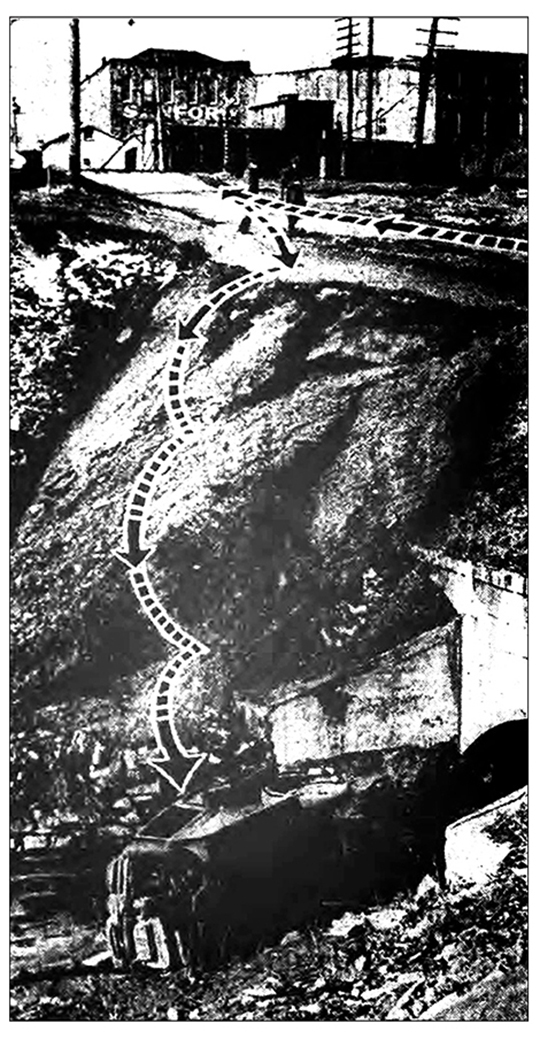 |
|
This Syracuse Journal photo illustration shows what happened to the Kosecki vehicle, which backed off the road and tumbled into a small brook below. |
|
Sorry, the refreshment stand is closed |
|
|
|
A collision of trains was fairly common at the time. The following occurred in Solvay at Bridge Street, which may have been crossed by more railroad tracks than any other street in the county, thanks to the nearby presence of the Solvay Process Company. One of the men mentioned in the story is identified as William Olgeaty, whose last name may be spelled correctly, though I could find no other reference to anyone by that last name. My hunch was his name might actually have been Olgeaty, a familiar Solvay last name, but I could find no William Olgeaty listed anywhere. |
|
|
|
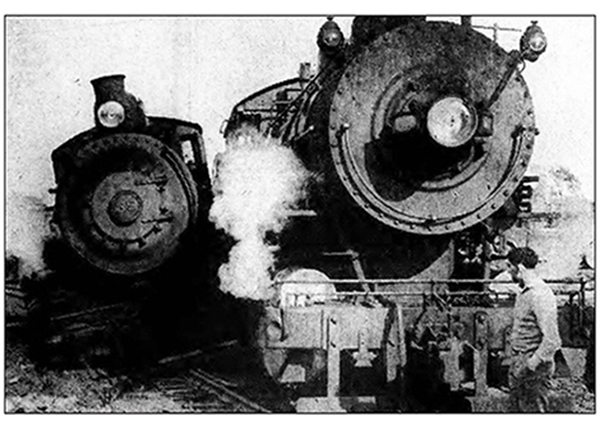 |
|
On October 9, Frederick J. Strotman of 323 Cedar Street, Syracuse, was fatally injured when struck by a Delaware, Lackawanna & Western train on tracks near the Solvay Process. He was a New York Central Railroad section hand. Strotman and other members of a crew were getting out of the way of an eastbound New York Central passenger train, when a westbound Lackawanna passenger train approached on the adjacent set of tracks. It was the second deadly accident for DL&W within 24 hours. A day earlier Bert Klock, 66, of 509 Seymour Street, a veteran freight conductor, was killed after he slipped while climbing to the roof of a boxcar and fell between two cars at Wyoming and West Fayette streets in Syracuse. |
|
| Also ... | |
| The beer war of '33 Prohibition continued and Syracuse Police Chief Martin L. Cadin concentrated on what he described as "a beer war." Arrested as members of “the Solvay gang” on January 3 were John Hogan, 37, of 102 Kane Road; Dennis McCarthy, 25, and Francis McCarthy, 23, brothers, of 102 Caroline Avenue, Solvay; Anthony Petta, 34, of 1202 Willis Avenues; Michael DeSteffano, 26, of 133 Kappesser Street; Thomas Kowal, 27, of 116 Pulaski Street; Patrick Foley, 22, of 310 Erie Street, and John Holihan, 28, of 314 Cayuga Street. |
|
| Four escape early morning fire Awakened by smoke fumes on March 11 about 1 a.m., Mrs. Peter DeAlbert, 501 Cogswell Avenue, Solvay, sent her daughter, Miss Inez De Albert, to run two blocks to sound the alarm. Solvay firemen made short work of the fire, which started in the basement. Damage is estimated at less than $1,000. Mr. and Mrs. Joseph De Albert, son and daughter-in-law of the house owners, also were driven to the street in their night clothing by the blaze. |
|
Mail box bomber is 14-year-old boy |
|
| House destroyed, family safe Mr. and Mrs. Alexander Smelkoff of Pleasant Beach, and their 16-year-old son, Michael, escaped a fast-moving fire that destroyed their house on July 28. The fire gained headway so rapidly that Solvay volunteers were unable to save any part of the building. However, they succeeded in preventing spreading of the flames to adjoining structures. A defective chimney connecting with a kitchen stove caused the fire. Family members were unable to save any of their valuables or furniture. |
|
| Hey, it's the annual Solvay Process fire! No year was complete without one of these: a blaze from oil and benzol on the water of a pond in the Solvay Process Company waste lands on State Fair Boulevard. The mixture burned furiously for about 90 minutes on August 8, and the village of Solvay and its environs were darkened by huge clouds of black smoke belched out of the fire. Prospect Hose Company of Solvay was called to the scene and extinguished the blaze within minutes, but not until after hundreds of automobiles had arrived and created a serious traffic tie-up. Smoke from the boil fire actually blotted out the sun in Solvay and vicinity and the entire village became dark an hour before sunset. |
|
| People | |
Santos Mozo wins radio contest |
|
Charles R. Hall re-elected mayor |
|
|
|
| Deaths | |
|
|
|
|
|
|
|
|
|
|
|
|
|
|
|
|
| Sports | |
Baseball: Solvay High dethroned Players mentioned in various newspaper stories were first baseman W. Fiesinger, second basemen Bome and Lombard, shortstop Mascette, third baseman (and captain) Johnny Brostek, outfielders Wheeler, Gettman, Szczech and Joe Brostek, catcher Salvetti and pitcher Joe Kinsella. However, the season did not end well in the league's championship game which pitted Solvay against eastern division winner North Syracuse. Solvay was beaten, 8-2. |
|
Solvay Firemen pulled two big upsets Opponents included town teams from Onondaga County and beyond, though the highlight of the season was a June 11 game at Woods Road Field against the Syracuse Colored Dunbars. The Solvay Firemen won 7-6. According to the Syracuse Journal, it was the Dunbars’ first loss in three seasons. On July 4, the Fireman handed the Polish-American Citizens team its first loss of the year, 6-5. The Polish-American Citizens team is not to be confused with the Solvay Polish Club (below). Several Polish organizations in Central New York fielded athletic teams, though their rosters often included players who, if they were Polish, it was on their mother's side. |
|
Solvay's Polish Club baseball team When the league was formally organized, on April 16, with former major league pitcher George Wiltse installed as president, the eight member teams included the Solvay Polish Club, which was big news in the village. (The other teams included two from the city, Marksons and Byrne-Seiberling, plus the Oswego Polish-Americans, Chappie Johnson's All-Stars (an all-Negro team), and clubs from Camden, North Syracuse and Liverpool. A day later, teams from Fulton and Auburn were added. However, Auburn soon dropped out, leaving the league with nine teams, one of which would have to go. The league had an interesting method of determining the odd team out. Team managers, including John Pieklik of the Solvay Polish Club, voted for the team they believed was most valuable to the league's success. The team selected was Chappie Johnson's All-Stars, which, interestingly, had no home field. The managers then voted again, selecting the most valuable team from the seven remaining . . . then six . . . five . . . four . . . etc. The Solvay Polish Club was viewed as the least valuable and was sent packing with the promise that they would be the next team added to the league. That promise would be broken weeks later when the North Syracuse team was dropped from the league and replaced by a team from Auburn, whose manager hadn't bothered to attend the league's important organizational meeting in April. ANOTHER reason the Polish Club was uninvited to join the league was its lack of a baseball facility enclosed by a fence and a grandstand. President Wiltse set the admission price for league games at a quarter. When league play began on May, members of the Solvay Polish Club must have had a good laugh. Two of the better teams, Marksons (representing a Syracuse furniture store) and Byrne-Seiberling (representing a tire company) opened their season on a North Syracuse baseball field that was not enclosed by a fence and lacked a grandstand. There weren't enough police on hand to control the crowd, which lined up along the first and third baselines, risking serious injury from foul balls. Byrne Seiberling won the game and Marksons protested, to no avail. Then, on May 9, the Solvay Polish Club played the "most valuable" Chappie's All-Stars played in a non-league contest— and beat them, 8-7, after trailing, 6-0, early in the game. Admittedly, the Polish Club did not fare as well in other games against member of the semi-pro league, though it won almost all its games against other regional baseball teams. AS WAS the usual case at the time, players often were identified in newspaper stories by only their last names. Polish Club players included three pitchers — Kotash, Kozack and Falkowski— and other players named Progowski, Murphy, March, Kazel, Kellogg, Berlinski, Grabowski, Mokaw, Cook, Bamerick and Kobuszewski. The Polish Club started work on improving their facility on Bridge Street by putting a 10-foot wooden fence on all four sides, with a 60-foot canvas blocking the view from the bridge on the east side of the field. A grandstand with a 2,000 seating capacity was to be built from first to third base, and bleachers, running from the end of the grandstand to the outfield, would seat 1,500 more. Chappie's All-Stars were organized and managed by George "Chappie" Johnson, who had been a catcher for many years in the Negro Leagues. His team was considered the most entertaining in the Journal-American league, though it clearly was not the best, finishing in fourth place. The league had a split season, with teams playing each other twice in both the first half and the second half. Chappie's won 14 games, lost 14. The Marksons team, after its controversial opening day loss, won 22 of 28 games overall. But the problem with split seasons is the possibility that the team with the best overall record will not qualify for the playoff between the winner of the first half and the winner of the second half. And so it went with Marksons, which finished one game behind Byrne-Seiberlings in the first half of the season, and tied Oswego in the second half. Oswego beat Marksons in a special playoff, then won the best-of-seven championship series against Byrne-Seiberlings. INTERESTINGLY, there was an all-star game after the series. Ordinarily the championship team would play all-stars from the other seven teams. But in this case the all-stars played Chappie's team, making me suspect it was done this way to avoid having the all-stars field an integrated team. There was, however, one white team that had a Negro player. Pitcher Jess Winters, released by Chappie's All-Stars, then signed with the Futon team. In his first game with Fulton he faced his old teammates — and was shelled. A year later the Syracuse Chiefs were born and played in the International League, then a Class AA minor league organization. |
|
However, Solvay was well represented in the Syracuse Semi-Pro Baseball League by second baseman Johnny Zulberti, who emerged as one of the league's brightest stars |
|
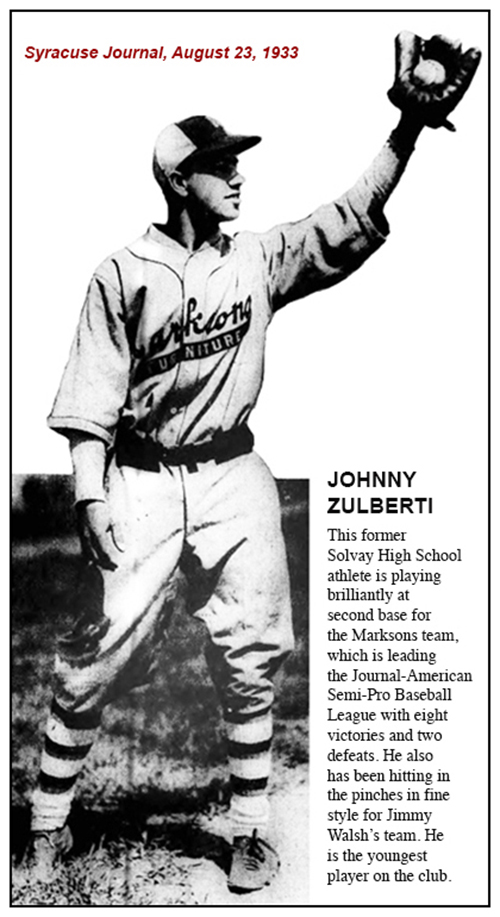 |
|
Other teams Players mentioned in items about the Asbury team were pitcher F. Darrow, catcher S. Darrow, and two others, Hunt and Forth. Another Solvay team represented the Pirro Undertakers. Milton A. C. participated in a three-team playoff with the Solvay Tigers and the Solvay Polish Club, to decide the village championship, but lost to both teams. The Tigers, for reasons not explained in the Syracuse Journal, forfeited their game against the Polish Club, which then claimed the Solvay championship. According to the Journal, the Polish Club won 26 games and lost only seven. Pitcher Frank Kotash had an 11-3 record, and struck out 125 batters. Red Falkowski was 10-3. Shultz was undefeated in four games and Kossack won one game. Berlinski, Pogroski, Jasinski and Orzell were the leading hitters. |
|
Basketball: Solvay High rules — again They won the Central Division, then beat Eastern Division champ Minoa in the first playoff game and followed that with a victory over Western Division champ Warners High School. Solvay players mentioned in Syracuse Journal stories were Blair, Joe Brostek, John Brostek, John Forken (captain), Gettman, Gulbert, Olgeaty, "Slim" Salvetti, Johnny Zulberti. There may have been confusion over the Brostek brothers in the newspaper stories, which for several games had John Brostek high scorer, but at the end of the season said Joe Brostek, co-captain, not only was the Solvay high scorer for the season, but led the league as well. It's more likely that the reference to Joe Brostek was in error because he was younger than brother John and likely was a sophomore, while John was a senior. However, when Solvay opened its 1933-34 season with a 40-24 win over Jordan High School, the Brostek who "led the attack with 17 points" almost certainly was Joe. Other members of that team were Chesneski, Ferrante, R. Flaherty, A. Bieganowski, V. Bieganowski, Semino and Wheeler. There would be no fifth consecutive league championship for the Bearcats, who barely made the playoffs and were eliminated in the first round. |
|
Whippet Blue Blades best in town of Geddes But until March 31, the Whippet Blue Blades — named for a razor company — would win almost every game, including a 35-30 victory over the West Genesee Church on January 25. It was the first loss for West Genesee in 18 games. Blue Blade players included Armani, Chesneski, Cohen, Forken, Gallante, Gettman, Hayes, Friedli, Kinnally, Salvetti, Spillett and the Chamberlin brothers. The Blue Blades won 11 of their first 12 games during the 1932-33 season, their only loss, 38-37 in overtime, coming against the Geddes Bonds, whose players included several from Solvay High School. As usual, the newspapers mentioned only last names, and the Geddes roster included Cloonan, Cosgrove, Costello, Jerome, Kennedy, Pfieffer and Tindall. When the two teams played again in January, the Whippet Blue Blades prevailed, 25-22, on the Solvay High School court. Another Solvay team was Milton A. C., defeated by the Blue Blades, 28-17, in February. Gettman was high scorer for the winners, Bresadola paced Milton with 10 points. Other Milton players: Balduzzi, Bendetti, Bucci, Pasco, Armani and Galante. The Solvay Firemen had a basketball team. They, too, played the Whippet Blue Blades, and lost, 37-21. Rosters at the time must have been flexible. When the Firemen played a team called the New York Telephone Engineers, winning, 42-21, their players included Chesneski, two members of the Friedli family and Spillet, all of who may have played some games for the Blue Blades. Other Firemen players were Beagle, Darrow, Anderson and Hunt. Emerging as probably the area's best local semi-pro team was the Polish American Citizens Club. They were in a whole other world, proving it when the beat the Blue Blades, 71-35, on February 25. However, the Blue Blades finished their season with 34 wins and six losses. |
|
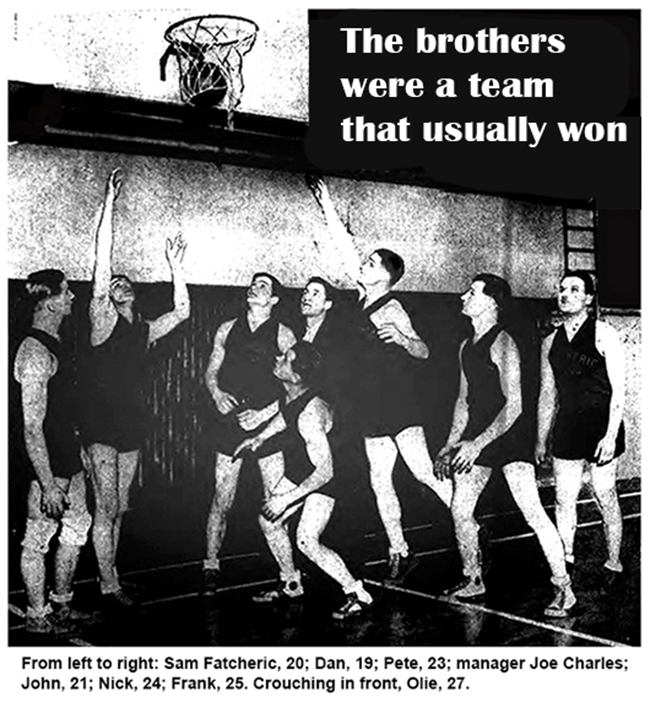 |
|
|
|
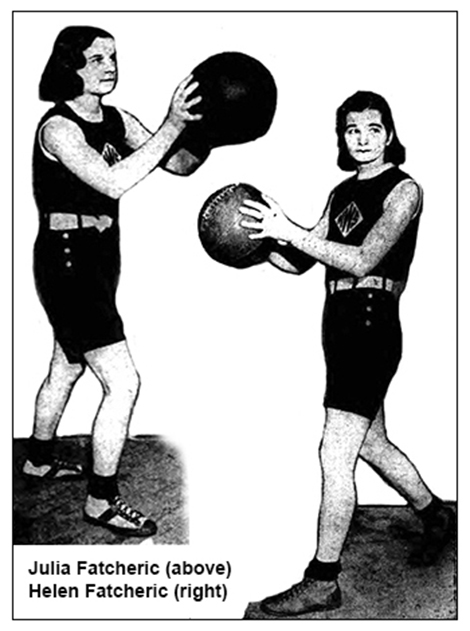 |
|
No match for the Whippets |
|
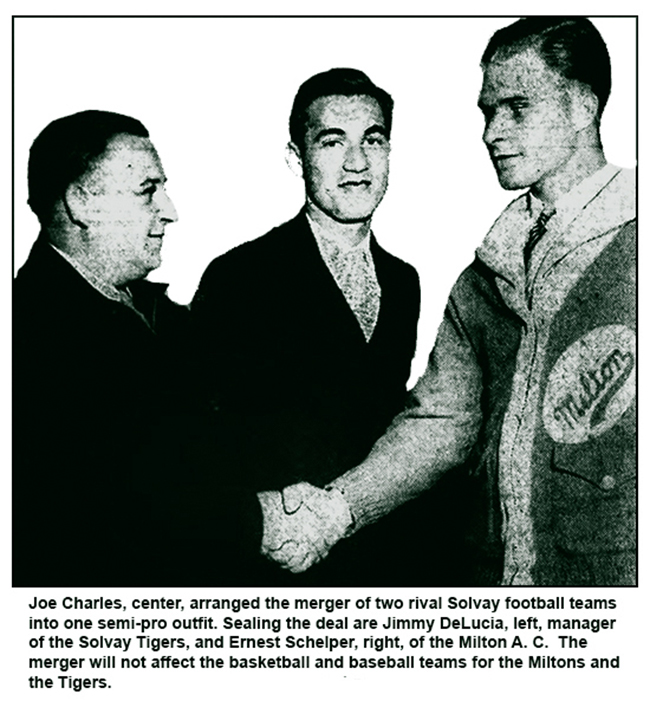 |
|
|
|
The result was a very successful team that went undefeated and unscored upon in eight games, though the Milton-Tigers had to settle for a scoreless tie against a team from Utica. |
|
Low-scoring Bearcat gridders falter On November 3. Solvay lost again, 14-6, to North Syracuse. Victories came at the expense of East Syracuse (7-0), Marcellus (7-0), and Manlius (13-0). Solvay players included Barragoli, Bethka, Bex, Bieganowski, Brostek, Caspeliani, Catslin, "Little Horse" Chesneski, Ferrante, Flaherty, Louise, Joe O'Leary, John O'Leary, Paussa, Pestiliana, Pestillo, Pettit, Pirro, Plantz, Raymond, Umbegi, Wheeler |
|
Streak ends for Solvay Aces Their winning streak ended in their opening game against a team from Syracuse called the West End Falcons, 7-0. The Aces were coached by Jumbo Plants, who took his team to Oswego to play a team made up of soldiers based at Fort Ontario. Once more the Aces went down to defeat, again by the score of 7-0. The Syracuse Journal listed the Aces line-up: Brostek, LE; Kinsella, LT; Fabrizio, LG; Renders, C; Mokwa, RG; Knapp, RT; Messere, RE; Hunt, QB; Martini, LH; Jost, RH; Bucci, FB. Subs: Darrow, J. Friedli, F. Friedli, Olgeaty, Wallace. |
|
| Advertisements |
|
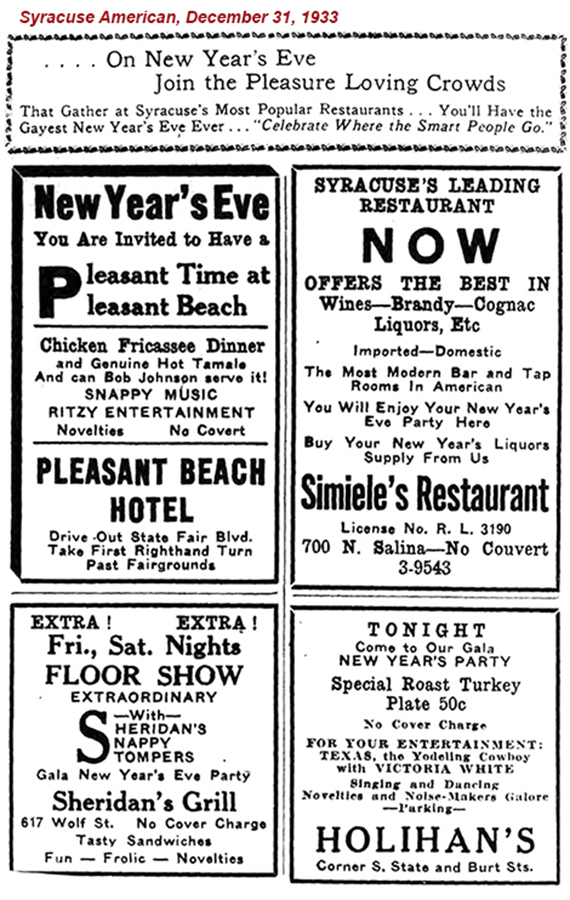 |
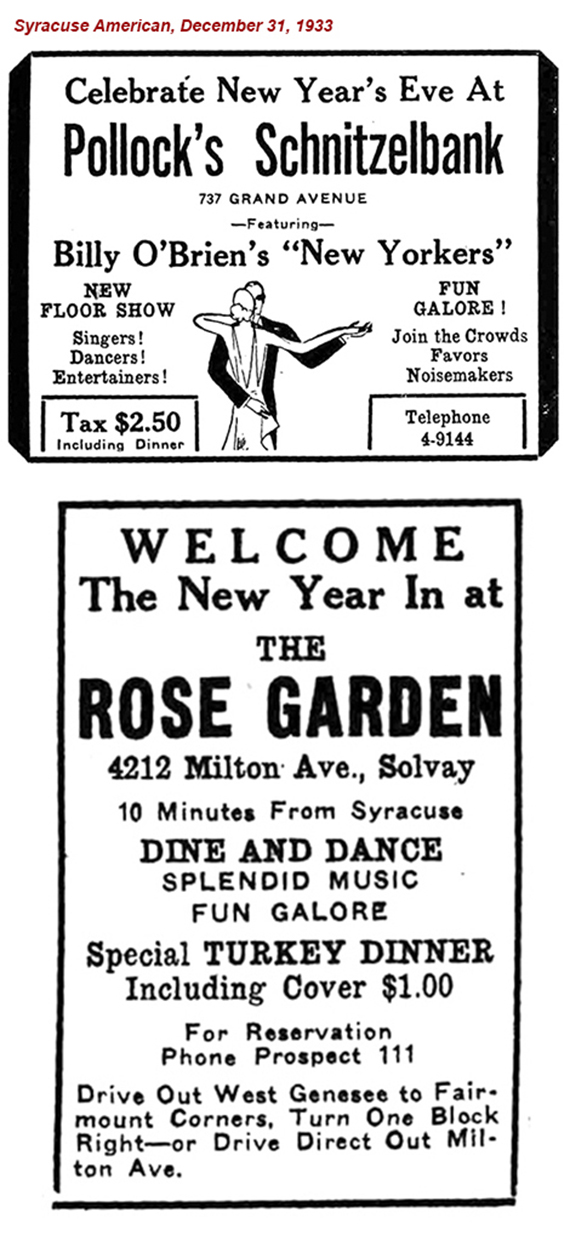 |
| Most items are from stories in the Syracuse Journal and its Sunday edition, the Herald-American. Several were edited for length. |
| For more on Solvay way back when, check out the Solvay-Geddes Historical Society |
| HOME • CONTACT |